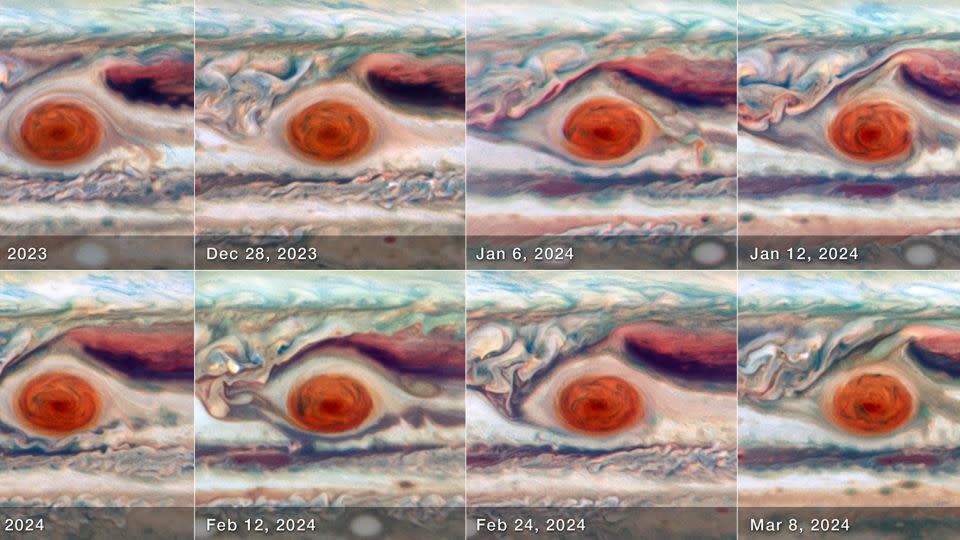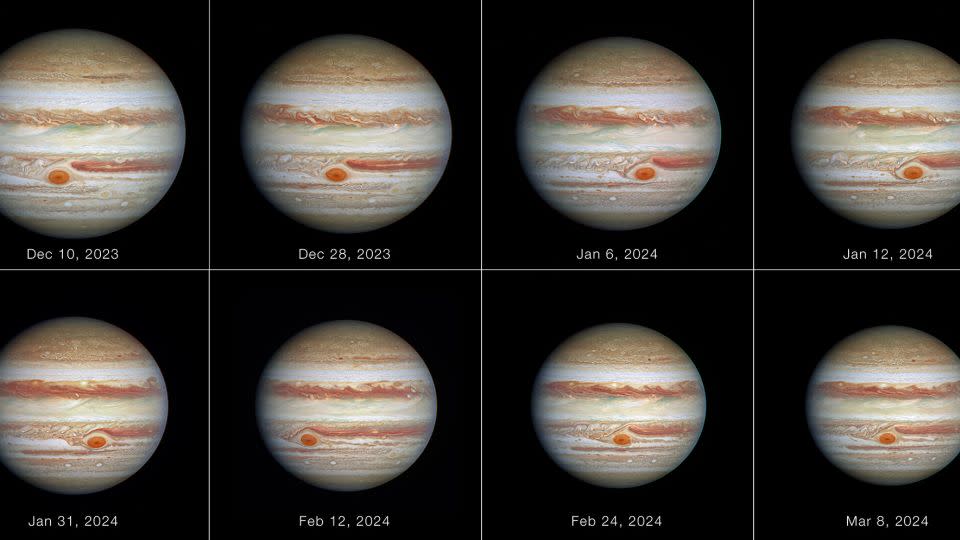Sign up for CNN’s Wonder Theory science newsletter. Explore the universe with news about fascinating discoveries, scientific developments and more.
New observations of Jupiter’s Great Red Spot captured by the Hubble Space Telescope show the 190-year-old storm wobbling like gelatin and changing shape like a squeezed stress ball.
Astronomers say the unexpected observations, which Hubble made over 90 days from December to March, show that the Great Red Spot is not as stable as it seems.
The Great Red Spot, or GRS, is an anticyclone, or large circulation of winds in Jupiter’s atmosphere, orbiting a central region of high pressure along the planet’s southern cloud belt at midlatitude. And the long-lived storm is so big — the largest in the solar system — that Earth could fit inside it.
Although storms are generally considered unstable, the Great Red Spot has existed for almost two centuries. But the observed changes in the storm appear to be related to its movement and size.
A time-lapse of the images shows that the vortex “wobbles” like gelatin, expanding and contracting over time.
Researchers described the observation in an analysis published in The Planetary Science Journal and presented Wednesday at the 56th annual meeting of the American Astronomical Society’s Division for Planetary Sciences in Boise, Idaho.
“Although we knew that the movement varies somewhat in the longitudinal direction, we did not expect the magnitude to fluctuate as well. To our knowledge, it has not been previously identified,” lead study author Amy Simon, a planetary scientist at NASA’s Goddard Space Flight Center in Greenbelt, Maryland, said in a statement.
“This is really the first time we’ve had the right frame rate from the GRS,” Simon said. “With Hubble’s high resolution, we can say that the GRS is definitely wriggling in and out as it moves faster and slower. That was very unexpected.”

A shifting alien storm
Astronomers have been observing the iconic crimson feature for at least 150 years, and sometimes the observations lead to surprises, including the latest revelation that the storm’s oval shape can change size, sometimes appearing skinnier or fatter.
Recently, a separate team of astronomers using the James Webb Space Telescope looked into the heart of the Great Red Spot to capture new details in infrared light. The Hubble observations were made in visible and ultraviolet light.
The study, published September 27 in the Journal of Geophysical Research: Planets, revealed that the Great Red Spot is cold at its center, causing ammonia and water in the vortex to condense and form thick clouds. The research team also discovered the gas phosphine in the storm, which “could play a role in generating those mysterious” red colors that make the Great Red Spot so iconic, said co-author Leigh Fletcher, professor of planetary sciences at Britain’s University of London. Leicester, in a statement.
NASA scientists use Hubble’s keen eye to monitor the storm’s behavior once a year through the Outer Planet Atmospheres Legacy, or OPAL, program, which Simon leads. Scientists use this program to observe the outer planets in our solar system and see how they change over time.
But the new observations were made separately through a program dedicated to studying the Great Red Spot in more detail by looking at how the storm changed over a few months, rather than a one-time, annual snapshot.
“To the untrained eye, Jupiter’s striped clouds and famous red storm can appear static, stable and long-lived for years,” says Fletcher. “But closer inspection reveals incredible variability, with chaotic weather patterns as complex as anything we have here on Earth. Planetary scientists have been striving for years to see patterns in this variation, anything that could give us some insight into the physics underlying this complex system.”
Fletcher was not involved in the new investigation.
The insights gleaned from the program’s observations of our solar system’s largest storms can help scientists understand what weather might be like on exoplanets orbiting other stars. That knowledge can expand their understanding of meteorological processes beyond those we experience on Earth.
Simon’s team used Hubble’s high-resolution images to take a detailed look at the size, shape and color changes of the Great Red Spot.
“If we look closely, we see that many things change from day to day,” Simon said.
The changes include a brightening of the storm’s core when the Great Red Spot is at its largest size as it oscillates.
“As it speeds up and slows down, the GRS pushes against the windy jet streams north and south of it,” said co-author Mike Wong, a planetary scientist at the University of California, Berkeley, in a statement. “It’s similar to a sandwich where the bread slices are forced to bulge if there is too much filling in the middle.”
On Neptune, dark spots can drift across the planet because no strong jet streams hold them in place, Wong said, while the Great Red Spot is trapped between jet streams at a southern latitude on Jupiter.
A shrinking place
Astronomers have watched the Great Red Spot shrink since the OPAL program began a decade ago and predict that it will continue to shrink until it reaches a stable, less elongated shape, which could reduce the wobble.
“Right now it’s overfilling its latitude relative to the wind field. Once it shrinks within that band, the winds will really hold it in place,” Simon said.


The new Hubble study fills in more pieces of the Great Red Spot puzzle, Fletcher said. Although scientists know that the storm’s westward drift has an unexplained 90-day oscillation, the accelerating and decelerating pattern doesn’t seem to change even as the storm shrinks, he said.
“By watching the GRS for a few months, Hubble has shown that the anticyclone itself changes shape with this oscillation,” Fletcher said. “The shape change is important because it can affect how the edge of the vortex interacts with other passing storms. In addition to the beautiful Hubble images, this study shows the power of observing atmospheric systems over long periods of time. You need that kind of monitoring to discover these patterns, and it is clear that the longer you look, the more structure you see in the chaotic weather.”
For more CNN news and newsletters, create an account at CNN.com